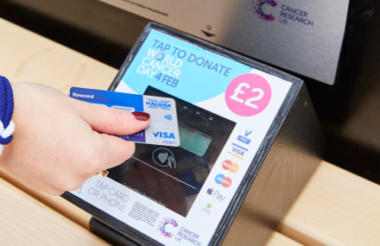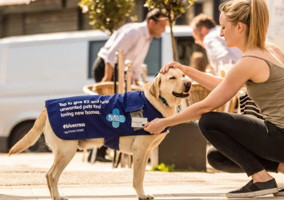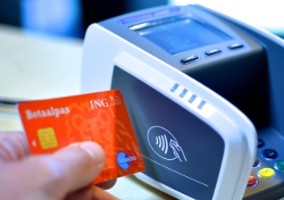Is ‘tap-to-donate’ technology a game changer for fundraising, or is it just a bit of a gimmick? Kirsty Weakley investigates.
There has been a proliferation in the number of charities experimenting with contactless payment technology to encourage people to ‘tap-to-donate’. According to a recent Mastercard study 43 per cent of people carry less cash than they did two years ago, so it’s easy to see why charities have been thinking about how to harness this technology to fundraise.
Some of the early results from charity trials appear to be encouraging, but some campaigns, such as the Blue Cross’s donation jackets for dogs, have just the faintest whiff of a PR gimmick about them.
What is it?
Contactless payment technology can be incorporated into pretty much anything –often debit and cards or smartphones, but it can also be incorporated into key fobs, stickers and wearable devices. When the device is tapped against a contactless payment terminal purchase information is transmitted.
It can currently be used for purchases of £30 and under, and the latest figures from the UK Cards Association show that one quarter of all card payments last November were made using contactless devices.
In 2015, the Charities Aid Foundation, in partnership with Save the Children, carried out a trial using contactless collection boxes at various cities around the country, the results of which predicted that the technology had a “massive future” for the sector.
Between September and December last year Barclaycard issued 100 lightweight, contactless donation boxes to 11 charities, which between them raised £20,000 during the trial.
Chris Allwood, head of product development at CAF, said that the technology doesn’t just act as a “replacement for cash” but could also unlock extra money for the charity sector.
“We’ve found people giving higher value donations with contactless,” he says. “So the giving potential might be greater.”
As part of the Barclaycard trial, the NSPCC said its average donation was just over £3, which was significantly more than it expects from cash donations.
Who’s done it?
A number of charities have been experimenting with different ways of using the technology to raise money, but tangible results so far seem relatively limited. For the most part it seems like charities are still in the early stages of developing and learning from these campaigns.
One of the most high-profile initiatives, which for obvious reasons received a lot of national media coverage, was when Blue Cross fitted some of its canine ambassadors with special jackets that enabled them to take donations.
A spokeswoman for the charity describes it as “for awareness more than a key fundraising tool”, but adds that the charity is looking at new ways of using the technology at events this year.
Cancer Research UK has tried a number of things. It has fitted contactless donation points to shop windows, equipped fundraisers with contactless terminals ahead of World Cancer Day in 2016 and last month became the first brand partner for a wireless bench, which included a contactless donation feature.
Paul Weaver, digital innovation lead at Cancer Research UK, says: “We believe that providing supporters with a mechanism that allows them to instantly donate in response to out of home media has the potential to completely change the way charities fundraising in the future.”
Before trialling contactless donations, Oxfam has experimented with near-field communication (NFC) and augmented reality projects and, like CRUK, used its charity shops as a jumping off point for the technology.
Matt Jerwood, digital fundraising lead, says that introducing NFC technology, where smartphone users could scan a poster in an Oxfam shop to open a donation page and find out more about the charity, taught them that “customers didn’t really know that their phones had that capability” and engage with the new types of content.
The next thing Oxfam tried was an augmented reality app, which again unlocked content and offered the option to donate. Jerwood says that “people thought it was very interesting” but he’s not sure that it really opened a new stream of giving.
But, he adds, people know about contactless donations and so it “could be an alternative to cash collection”.
Barriers to uptake
At the moment the technology is still in the early stages, so the biggest barriers are the fact the devices are still quite costly at around £100 and that they are not readily available.
Jerwood says the only ones that Oxfam has used so far are those that were leant to it. “Clearly cost will be an important decision” before investing on a large scale, he says.
Allwood adds that when it comes to replacing a street collection tin with a contactless version there is “nothing on the market yet that we can just go and buy”.
Devices are also hard to get. There are three elements that come separately: the hardware; the payment gateway software; and the banking facility.
In the early days, a lack of public awareness was an issue, but that is becoming less and less of a problem.
Allwood says that when CAF carried out its first trial around the country, it noticed that there was “a better response in some places than in others”.
Notably, Londoners were much more likely to make a contactless donation than elsewhere. He puts this down the prevalence of Oyster cards to tap and pay for public transport in the capital meaning that “people had got used to tapping cards on stuff”.
What next?
According to Allwood, charities shouldn’t underestimate the importance of the “effect of having a person” involved in the fundraising ask.
Allwood highlights that a CAF trial using counter-top tap-to-donate points in Costa found that, if unprompted, one in five customers paying with contactless would also donate. But that if the barista suggested that they donate it increased to one in two.
For CRUK it is still early days and it is working to increase scale and awareness. Weaver says it is “all about staying relevant in a fast moving world”.
Jerwood says that at Oxfam it is a “continuous process” of learning and developing. He would like to see the technology evolve to the point where making a donation could “unlock some content” for the supporter.
Related articles












